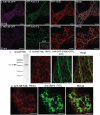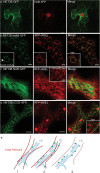NETWORKED 3B: a novel protein in the actin cytoskeleton-endoplasmic reticulum interaction
- PMID: 28369569
- PMCID: PMC5441911
- DOI: 10.1093/jxb/erx047
NETWORKED 3B: a novel protein in the actin cytoskeleton-endoplasmic reticulum interaction
Abstract
In plants movement of the endoplasmic reticulum (ER) is dependent on the actin cytoskeleton. However little is known about proteins that link the ER membrane and the actin cytoskeleton. Here we identified a novel protein, NETWORKED 3B (NET3B), which is associated with the ER and actin cytoskeleton in vivo. NET3B belongs to a superfamily of plant specific actin binding proteins, the NETWORKED family. NET3B associates with the actin cytoskeleton in vivo through an N-terminal NET actin binding (NAB) domain, which has been well-characterized in other members of the NET family. A three amino acid insertion, Val-Glu-Asp, in the NAB domain of NET3B appears to lower its ability to localize to the actin cytoskeleton compared with NET1A, the founding member of the NET family. The C-terminal domain of NET3B links the protein to the ER. Overexpression of NET3B enhanced the association between the ER and the actin cytoskeleton, and the extent of this association was dependent on the amount of NET3B available. Another effect of NET3B overexpression was a reduction in ER membrane diffusion. In conclusion, our results revealed that NET3B modulates ER and actin cytoskeleton interactions in higher plants.
Keywords: Actin cytoskeleton; N. benthamiana.; NET superfamily; endomembrane system; endoplasmic reticulum.
© The Author 2017. Published by Oxford University Press on behalf of the Society for Experimental Biology.
Figures






Similar articles
-
The plant cytoskeleton, NET3C, and VAP27 mediate the link between the plasma membrane and endoplasmic reticulum.Curr Biol. 2014 Jun 16;24(12):1397-1405. doi: 10.1016/j.cub.2014.05.003. Epub 2014 Jun 5. Curr Biol. 2014. PMID: 24909329
-
Plant VAP27 proteins: domain characterization, intracellular localization and role in plant development.New Phytol. 2016 Jun;210(4):1311-26. doi: 10.1111/nph.13857. Epub 2016 Feb 1. New Phytol. 2016. PMID: 27159525
-
A superfamily of actin-binding proteins at the actin-membrane nexus of higher plants.Curr Biol. 2012 Sep 11;22(17):1595-600. doi: 10.1016/j.cub.2012.06.041. Epub 2012 Jul 26. Curr Biol. 2012. PMID: 22840520
-
Connecting membranes to the actin cytoskeleton.Curr Opin Plant Biol. 2017 Dec;40:71-76. doi: 10.1016/j.pbi.2017.07.008. Epub 2017 Aug 2. Curr Opin Plant Biol. 2017. PMID: 28779654 Review.
-
Plant cytoskeletons and the endoplasmic reticulum network organization.J Plant Physiol. 2021 Sep;264:153473. doi: 10.1016/j.jplph.2021.153473. Epub 2021 Jul 15. J Plant Physiol. 2021. PMID: 34298331 Review.
Cited by
-
A glossary of plant cell structures: Current insights and future questions.Plant Cell. 2022 Jan 20;34(1):10-52. doi: 10.1093/plcell/koab247. Plant Cell. 2022. PMID: 34633455 Free PMC article. Review.
-
Advances in Plant ER Architecture and Dynamics.Plant Physiol. 2018 Jan;176(1):178-186. doi: 10.1104/pp.17.01261. Epub 2017 Oct 6. Plant Physiol. 2018. PMID: 28986423 Free PMC article. Review.
-
MTV proteins unveil ER- and microtubule-associated compartments in the plant vacuolar trafficking pathway.Proc Natl Acad Sci U S A. 2020 May 5;117(18):9884-9895. doi: 10.1073/pnas.1919820117. Epub 2020 Apr 22. Proc Natl Acad Sci U S A. 2020. PMID: 32321832 Free PMC article.
-
Fine mapping and candidate gene analysis of gynoecy trait in chieh-qua (Benincasa hispida Cogn. var. chieh-qua How).Front Plant Sci. 2023 Apr 20;14:1158735. doi: 10.3389/fpls.2023.1158735. eCollection 2023. Front Plant Sci. 2023. PMID: 37152167 Free PMC article.
-
NET4 and RabG3 link actin to the tonoplast and facilitate cytoskeletal remodelling during stomatal immunity.Nat Commun. 2023 Sep 20;14(1):5848. doi: 10.1038/s41467-023-41337-z. Nat Commun. 2023. PMID: 37730720 Free PMC article.
References
-
- Boevink P, Oparka K, Santa Cruz S, Martin B, Betteridge A, Hawes C. 1998. Stacks on tracks: the plant Golgi apparatus traffics on an actin/ER network. The Plant Journal 15, 441–447. - PubMed
-
- Chen J, Stefano G, Brandizzi F, Zheng H. 2011. Arabidopsis RHD3 mediates the generation of the tubular ER network and is required for Golgi distribution and motility in plant cells. Journal of Cell Science 124, 2241–2252. - PubMed
-
- Deeks MJ, Calcutt JR, Ingle EK, et al. 2012. A superfamily of actin-binding proteins at the actin-membrane nexus of higher plants. Current Biology 22, 1595–1600. - PubMed
MeSH terms
Substances
Grants and funding
LinkOut - more resources
Full Text Sources
Other Literature Sources

